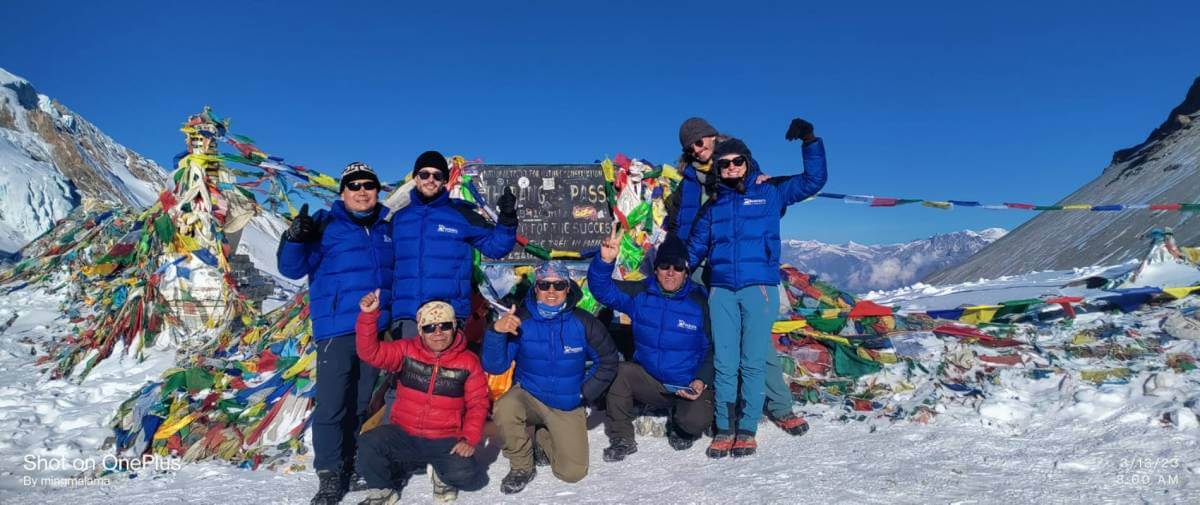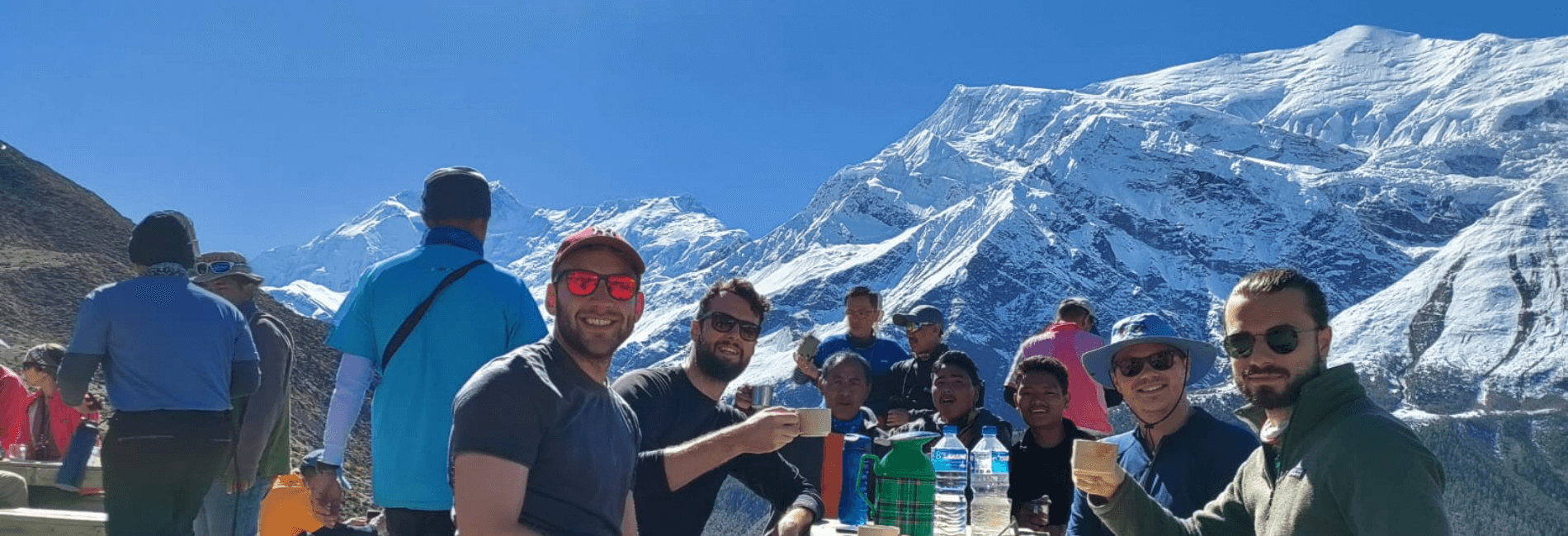26th August, 2025

Nov 14, 2023
Trekking the Annapurna Circuit: A Bucket List Adventure You Can't Miss
The Annapurna Circuit Trek is a popular trekking route in Nepal that takes you through a diverse range of landscapes, from lush subtropical forests to arid high-altitude deserts. The trek starts in the town of Besishahar and follows the Marsyangdi River valley, passing through traditional villages, terraced fields, and rhododendron forests.
As you ascend higher, the landscape becomes more barren and you will reach the Thorong La Pass, which is the highest point of the trek at 5,416 meters. From here, you will have stunning views of the surrounding mountains, including Annapurna, Dhaulagiri, and Manaslu.
The trek typically takes around 15-20 days to complete and covers a distance of approximately 230 km. Along the way, you will stay in teahouse lodges run by local families, where you can try traditional Nepalese food and experience the local culture.
The Annapurna Circuit Trek is considered a moderate to strenuous trek, and requires a good level of fitness and acclimatization to the high altitude. However, it is a rewarding and unforgettable experience that offers a unique insight into the natural beauty and culture of Nepal.

15 DAYS ANNAPURNA CIRCUIT TREK
A WILD ADVENTURE AMONG SOARING PEAKS - THE DEEPEST VALLEY ON EARTH & EXPOSURE TO UNIQUE CULTURES.THIS TREK HAS IT ALL!The 15 Days Annapurna Circuit Trek is time well spent and will leave you with...
Annapurna Circuit Trek Cost
The cost of the Annapurna Circuit Trek can vary depending on several factors such as the duration of the trek, mode of transportation, accommodation, food, permits, and guide/porter fees. On average, the cost of the Annapurna Circuit Trek can range from $800 to $1500 per person.
Porter
Hiring a porter is common practice on the Annapurna Circuit Trek, as it allows you to focus on enjoying the trek without the added burden of carrying a heavy backpack. Porters can carry up to 30 kg of weight and are paid around $15-25 per day, depending on the season and the weight they carry. It's important to treat your porter with respect and provide them with adequate food, accommodation, and warm clothing, especially at high altitudes.
Food
The Annapurna Circuit Trek offers a variety of food options, ranging from traditional Nepali dishes to international cuisine. Dal Bhat, a staple Nepali dish consisting of rice, lentil soup, and vegetables, is the most popular meal on the trek, providing much-needed energy and nutrition. Other popular dishes include momos, noodles, pasta, and pizza. It's recommended to stick to vegetarian meals to avoid food poisoning, and to carry snacks and water purification tablets for emergencies.
Accommodation
Accommodation on the Annapurna Circuit Trek ranges from basic teahouses to luxury lodges, depending on your budget and preferences. Teahouses are the most common type of accommodation, offering simple rooms with shared bathrooms and communal dining areas. Luxury lodges provide more comfortable rooms with private bathrooms, hot showers, and Wi-Fi, but are more expensive. It's important to book your accommodation in advance, especially during peak season (September-November and March-May).
Transportation
The Annapurna Circuit Trek starts and ends in either Besishahar or Nayapul, depending on your itinerary. The most common way to reach these starting points is by bus or jeep from Kathmandu or Pokhara. The journey takes around 6-10 hours, depending on the road conditions. You can also choose Nepal Motorbike Tour to explore Annapurna Peak. Once you reach the starting point, you can either walk or hire a jeep to reach the trailhead.
Permit
To trek in the Annapurna Conservation Area, you need to obtain a TIMS (Trekkers' Information Management System) card and an ACAP (Annapurna Conservation Area Permit) card. These cards can be obtained from the Nepal Tourism Board or the Immigration Office in Kathmandu or Pokhara. The cost of the TIMS card is around $10-20, depending on the season, while the ACAP card costs around $30 per person. It's important to carry these cards with you at all times during the trek, as they will be checked at various checkpoints along the way.

ANNAPURNA CIRCUIT TREK 7 DAYS
The 7 days Annapurna Circuit Trek is, for a good reason, one of the most popular treks in Nepal’s Annapurna Conservation Area where you will witness enormous snow-covered mountains, deep gorges &...
Tipping For Trekking Staff
Tipping is a common practice in Nepal, including on the Annapurna Circuit Trek. It's a way of showing appreciation and gratitude to the trekking staff for their hard work and dedication. Here are some tips on tipping on the Annapurna Circuit Trek:
1. Trekking Guide: It's common to tip the trekking guide at the end of the trek. The amount of the tip can vary depending on the length of the trek and the level of service provided. A general guideline is to tip 15-20% of the total cost of the trek.
2. Porter: Porters carry your luggage and other equipment during the trek. It's recommended to tip the porter at the end of the trek based on the weight of the load they carried. A general guideline is to tip 10-15% of the total cost of the trek, per porter.
3. Cook and Kitchen Staff: If you have a cook and kitchen staff on your trek, it's recommended to tip them at the end of the trek. The amount of the tip can vary depending on the level of service provided. A general guideline is to tip 10-15% of the total cost of the trek.
4. Tea House Staff: If you stay in tea houses during the trek, it's common to tip the tea house staff at the end of your stay. The amount of the tip can vary depending on the level of service provided. A general guideline is to tip 50-100 Nepali Rupees per day per person.
5. Other Trekking Staff: If you have any other trekking staff, such as a guide assistant or a horseman, it's recommended to tip them at the end of the trek based on the level of service provided.
Remember that tipping is expected by culture, but it's a way of showing appreciation and gratitude to the trekking staff for their hard work and dedication.
Altitude Sickness
Altitude sickness, also known as acute mountain sickness (AMS), is a potential risk for trekkers on the Annapurna Circuit Trek due to the high altitude. The highest point of the trek is the Thorong La Pass, which is at an altitude of 5,416 meters.
Altitude sickness is caused by a lack of oxygen at high altitudes, and symptoms can include headache, nausea, dizziness, and shortness of breath. It is important to take precautions to prevent altitude sickness, such as gradually acclimatizing to the altitude, staying hydrated, and taking rest days to allow your body to adjust.
To prevent altitude sickness, it's important to take the following precautions:
1. Acclimatize: Ascend slowly and take rest days to allow your body to adjust to the altitude.
2. Hydrate: Drink plenty of water and avoid alcohol and caffeine, which can dehydrate you.
3. Eat well: Eat a balanced diet with enough calories to maintain your energy levels.
4. Medication: Consider taking medication such as Diamox to help prevent altitude sickness. However, consult with a doctor before taking any medication.
5. Recognize symptoms: Be aware of the symptoms of altitude sickness and inform your guide immediately if you experience any of them.
If you experience severe symptoms of altitude sickness, you should descend immediately and seek medical attention. It's important to take altitude sickness seriously and to prioritize your health and safety while trekking.

ANNAPURNA CIRCUIT WITH TILICHO LAKE TREK 15 DAYS
This 15-day trek takes you through the Annapurna Conservation Area and to the highest alpine pass in the world – Thorong La Pass (5,416m/17,769ft) and to Tilicho Lake. You will also trek through the d...
Preparation for Annapurna Circuit Trek
Preparing for the Annapurna Circuit Trek is important to ensure a safe and enjoyable experience. Here are some tips to help you prepare for the trek:
1. Physical Fitness: The trek involves long days of walking and ascending to high altitudes. Therefore, it's essential to be in good physical condition to handle the challenges of the trek. It's recommended to start a regular exercise regime several months before the trek.
2. Trekking Gear: Invest in good quality trekking gear, including hiking boots, warm clothing, rain gear, and a comfortable backpack. It's also important to bring a sleeping bag and a trekking pole.
3. Altitude Sickness Prevention: Learn about altitude sickness and how to prevent it. It's recommended to take a few days to acclimatize before ascending to higher altitudes.
4. Travel Insurance: Purchase travel insurance that covers emergency medical evacuation and trekking at high altitudes.
5. Permits and Documentation: Obtain the necessary permits and documentation required for the trek, including the Annapurna Conservation Area Permit (ACAP) and the Trekkers' Information Management System (TIMS) card.
6. Training: Attend a basic mountaineering course or hire a professional guide for the trek.
7. Mental Preparation: Prepare yourself mentally for the trek, which involves long hours of walking and unpredictable weather conditions. It's essential to have a positive mindset and be mentally prepared for the challenges of the trek.
By following these tips, you can prepare yourself for the Annapurna Circuit Trek and have a safe and enjoyable experience.

Nar Phu Valley With Tilicho Lake Trek 15 Days
Embark on a transformative journey through the mystical landscapes of the Nar Phu Valley with Tilicho Lake Trek, a 15-day adventure that promises unparalleled natural beauty, cultural immersion, and t...
conclusion:
Annapurna Circuit Trek is a challenging and rewarding trek that requires adequate preparation and planning. Hiring a porter, sticking to vegetarian food, booking your accommodation in advance, arranging transportation, and obtaining the necessary permits are all important factors to consider before embarking on the trek. With the right preparation and mindset, the Annapurna Circuit Trek can be an unforgettable experience of a lifetime.
Any Questions? Let Us Know.
Recent Posts
17th June, 2025


















